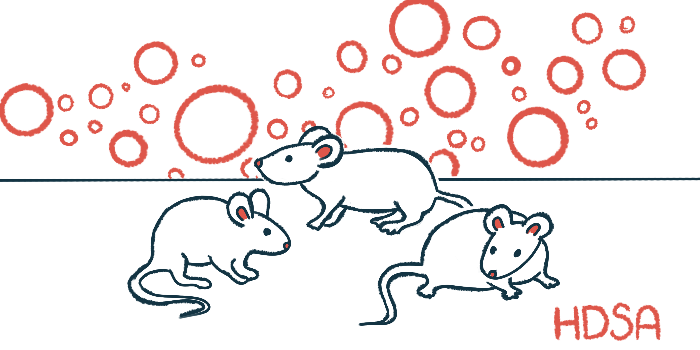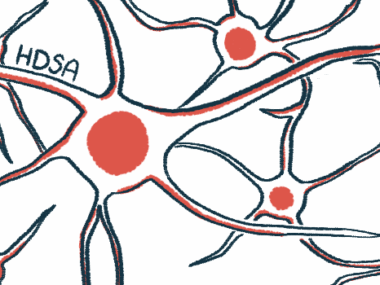HDSA 2025: Psychedelic compound eases depression in mice
Research fellows detail findings on depression, maternal infection
Written by |

Treatment with a nonhallucinogenic psychedelic compound may help to ease depression in people with Huntington’s disease, according to experiments done in a mouse model.
The research was done by Kaleigh Hanley, a scientist at the University of Central Florida’s College of Medicine. Hanley is one of the recipients of this year’s Donald A. King Summer Research Fellowship, an award offered by the Huntington’s Disease Society of America (HDSA) that supports undergraduate and early graduate students who are researching Huntington’s disease.
Hanley shared her findings at the HDSA’s 40th annual convention, held June 26-28 in Indianapolis. Her talk, “Testing a New Therapy for Depression in Huntington Disease Mice,” was part of a session called “Meet the Future of HD Research: HDSA Donald A. King Summer Research Fellows.”
Depression is associated with decreased neuroplasticity, or a reduction in the brain’s ability to reorganize and form new connections to adapt throughout life. This is thought to be one reason that people with depression often describe feeling more forgetful.
“That’s not just emotional, it’s linked to real changes in the brain,” Hanley said.
Psychedelics promote neuroplasticity, but may come with drawbacks
Depression is a common Huntington’s disease symptom, and it often doesn’t respond to available treatments. People with Huntington’s tend to have lower neuroplasticity due to the disease itself.
Psychedelic drugs are known to promote neuroplasticity, though many common psychedelics have drawbacks, such as inducing hallucinations.
Hanley’s study tested tabernanthalog, a compound that mimics the action of the hallucination-inducing psychedelic molecule ibogaine, but does not induce hallucinations. Ibogaine is found in a certain type of African shrub.
Previous studies have shown that tabernanthalog could promote neuroplasticity and reduce depression-like behaviors in non-Huntington’s mice. Hanley conducted experiments aiming to test whether tabernanthalog would have similar effects in a mouse model of Huntington’s.
To assess depression, the researchers used a validated experiment in which the mice are suspended in a beaker filled with water. Mice that aren’t depressed will swim to try to escape, whereas depressed mice will tend to go still and float despondently.
Results showed that Huntington’s mice treated with tabernanthalog were significantly more mobile than their untreated counterparts.
“Depression severity is decreased with [tabernanthalog treatment] in Huntington’s disease mice,” Hanley said.
HDSA fellow assesses maternal immune activation
Shai Lipkin, another recipient of this year’s Donald A. King Summer Research Fellowship and a scientist at the University of Central Florida in the same lab as Hanley, shared her work with mice at the HDSA convention in a talk titled, “How illness during pregnancy affects development of the HD brain.”
Research from as far back as the 1918 influenza pandemic has shown a link between infections during pregnancy and an increased risk of neurodevelopmental disorders in their offspring, Lipkin said.
“Already we are seeing increased rates of neurodevelopmental disorders being diagnosed in those who are exposed to Covid in utero,” Lipkin said. “This is caused by a process known as maternal immune activation, which is what happens when a pregnant woman gets sick.”
In such cases, the body produces more inflammatory molecules, including IL-6, that can cross the placenta and reach the fetus, “even though the virus itself is not,” Lipkin said.
This leads to an immune response in the fetus that causes inflammation during brain development and increased risk of neurodevelopmental disorders.
“If someone gets pregnant and they get sick at a point in time where their [fetus’] brain is developing, then this just happens naturally,” Lipkin said.
People with Huntington’s have been shown to have dysregulated immune activity, including abnormally high blood IL-6 levels. This is seen even at a stage when patients haven’t yet developed symptoms.
In someone carrying a Huntington’s-causing mutation and having a neurodevelopmental disorder, the age of Huntington’s symptom onset “is accelerated by four to six years,” Lipkin said.
It’s unclear, however, if infections during pregnancy may influence the development of Huntington’s.
Huntington’s mice vs. healthy mice
With this in mind, Lipkin conducted experiments in healthy mice and a mouse model of the disease.
Huntington’s mice displayed significantly higher repetitive, anxiety-like behaviors than healthy mice at older, but not younger, ages.
Pregnant mice were injected with a virus-like substance that would trigger an immune response, and the offspring were then evaluated for repetitive, anxiety-like behaviors.
As expected, pregnant mice given the viral mimic had higher blood IL-6 levels than those given a saline solution, indicating that “the offspring resulting from those litters injected with the viral mimic were exposed to maternal immune activation,” Lipkin said.
But despite being exposed to maternal immune activation, the offspring of Huntington’s mice showed similar levels of repetitive, anxiety-like behaviors as healthy mice.
“Maternal immune activation did not accelerate the onset of repetitive behaviors in [Huntington’s] mice,” Lipkin concluded, noting that work is ongoing to examine whether maternal immune activation affects the onset of cognitive, psychiatric-like, and brain changes associated with Huntington’s.
Note: The Huntington’s Disease News team is providing virtual coverage of the Huntington’s Disease Society of America annual convention June 26-28. Go here to see the latest stories from the conference.








